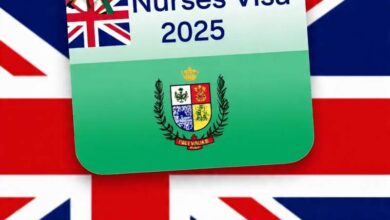Complete guide: How to Apply for a Work Visa as a Nurse in 2026 (USA, UK, Canada)

For many nurses, working abroad represents more than just a career move—it’s a chance to grow professionally, support their families, and experience a new healthcare system firsthand. Yet, the process can feel overwhelming, especially with changing immigration laws and requirements from country to country.

If you’ve been wondering how to apply for a work visa as a nurse in 2026, this guide is your clear and practical roadmap. Whether you’re aiming to start a new chapter in the USA, UK, or Canada, you’ll learn exactly what steps to take, what documents to prepare, and how to increase your chances of approval.
I still remember helping a close friend, a registered nurse from Kenya, navigate her UK work visa process. She was an exceptional nurse but nearly gave up after getting confused by multiple agencies and inconsistent advice online. With proper guidance, she successfully landed an NHS nursing job and received her visa approval within weeks. Her journey reminded me that sometimes, it’s not the lack of opportunity—it’s the lack of clear direction.
That’s why this article breaks everything down in simple, practical terms. You’ll discover the visa types available for nurses in 2026, eligibility criteria, application timelines, and tips to avoid common mistakes that delay approvals. Whether you’re just starting your nursing career or have years of experience, this guide will help you confidently apply for your work visa and take your next step toward an international nursing career.
Why Nurses Are in High Demand Abroad
Before diving into how to apply for a work visa as a nurse in 2026, it’s important to understand why countries like the USA, UK, and Canada are actively recruiting foreign-trained nurses. The global nursing shortage has reached critical levels, with thousands of healthcare facilities facing staff gaps caused by retirements, burnout, and growing healthcare demands.
In 2026, these nations are projected to have some of the highest nursing job vacancies in the world:
-
USA: The Bureau of Labor Statistics predicts over 200,000 new nursing positions each year.
-
UK: The National Health Service (NHS) continues to welcome thousands of overseas nurses annually to fill persistent workforce shortages.
-
Canada: Provinces like Ontario, Alberta, and British Columbia are offering streamlined immigration pathways to attract qualified international nurses.
For nurses across Africa and Asia, this demand translates into real opportunities—competitive salaries, career progression, and the chance to gain world-class experience. However, the first and most crucial step toward working in any of these countries is securing the appropriate work visa.
Each destination has its own rules, visa categories, and document requirements. Understanding these details early will help you avoid rejections and prepare your application strategically.
In the next sections, we’ll explore exactly how to apply for a nursing work visa in the USA, UK, and Canada, including eligibility, step-by-step procedures, and expert tips to make your application stand out in 2026.
Power Guide: How to Verify Nursing Documents for UK NMC from Nigeria 2025
How to Apply for a Work Visa as a Nurse in the USA (2026 Step-by-Step Guide)
Securing a nursing job in the USA starts with obtaining the right work visa. For 2026, the most common visa types for foreign nurses are the H-1B visa, EB-3 green card, and the TN visa for Canadian and Mexican nurses. Here’s a clear step-by-step guide to help you navigate the process.
Step 1: Meet the Educational and Licensing Requirements
Before applying, ensure you have:
-
A valid nursing degree from an accredited institution.
-
Your credentials evaluated by the CGFNS (Commission on Graduates of Foreign Nursing Schools).
-
Passed the NCLEX-RN exam, which is mandatory for U.S. nursing practice.
Step 2: Secure a Job Offer from a U.S. Employer
You must have a confirmed job offer from a U.S. hospital or healthcare facility that is willing to sponsor your visa. Most hospitals assist with the visa petition if you meet their qualifications.
Step 3: Employer Files the Visa Petition
-
For H-1B, the employer submits Form I-129 to the U.S. Citizenship and Immigration Services (USCIS).
-
For EB-3, the employer initiates the PERM labor certification before filing Form I-140.
-
Approval of these petitions is mandatory before you can apply for a visa stamp at the U.S. consulate.
Step 4: Apply for Visa at the U.S. Consulate
Once the petition is approved:
-
Complete DS-160 online application.
-
Schedule a consular interview.
-
Prepare supporting documents: passport, job offer, educational credentials, CGFNS certificate, NCLEX-RN results, and proof of experience.
Step 5: Attend the Visa Interview
During your interview, expect questions about:
-
Your nursing experience and qualifications
-
Your U.S. employer and job role
-
Your intent to abide by U.S. immigration laws
Step 6: Receive Visa and Prepare for Arrival
Once approved, your visa will be stamped in your passport. You can then travel to the U.S., start your orientation at the hospital, and begin your nursing career.
Essential Documents and Preparation Tips for Nurses Applying for a Work Visa in 2026
Proper preparation is key to a smooth visa application. Having all your documents ready and verified before you submit your application can save weeks of delays.

While requirements vary slightly by country, the following documents are essential for most nurse work visas in the USA, UK, and Canada:
1. Personal Identification
-
Valid passport with at least six months of remaining validity
-
Birth certificate (if required)
-
Passport-sized photographs meeting embassy specifications
2. Educational and Professional Credentials
-
Nursing diploma or degree
-
Transcript of records from your nursing school
-
Professional license or registration in your home country
-
Credential evaluation report (e.g., CGFNS for the USA or provincial regulatory bodies in Canada)
3. Work Experience Documents
-
Letters of recommendation from previous employers
-
Employment verification letters showing job title, dates, and responsibilities
4. Licensing and Exam Proof
-
NCLEX-RN exam results for the USA
-
NMC registration confirmation for the UK
-
Provincial equivalency or NCLEX-RN results for Canada
5. Visa-Specific Forms
-
Job offer letter from a licensed healthcare employer
-
Completed visa application forms (online or paper-based depending on the country)
-
Proof of English proficiency (IELTS or equivalent) if required
Preparation Tips
-
Double-check all documents: Even minor inconsistencies can lead to delays or rejections.
-
Keep both digital and hard copies: Embassies and immigration authorities often request originals and scanned copies.
-
Start early: Licensing exams, credential evaluations, and visa approvals can take months, so plan at least 6–12 months in advance.
-
Track deadlines: Each country has specific timelines for submitting documents and attending interviews.
By organizing your documents and preparing early, you significantly improve your chances of a smooth approval process. The next section will cover common mistakes to avoid when applying for a work visa as a nurse, helping you prevent delays and increase your chances of success.
Common Mistakes to Avoid When Applying for a Work Visa as a Nurse
Even with a strong application, small errors can cause delays or even visa denial. Being aware of these common pitfalls can save you time, money, and stress.
1. Missing or Incomplete Documentation
One of the most frequent mistakes is submitting incomplete or incorrectly formatted documents. Always double-check that you have all required forms, identification, and credential evaluations. Missing transcripts, unverified licenses, or outdated passports can lead to unnecessary delays.
2. Not Meeting Licensing or Exam Requirements
For the USA, passing the NCLEX-RN is mandatory. In the UK, you must be registered with the Nursing and Midwifery Council, and in Canada, provincial equivalency exams may be required. Skipping or misunderstanding these steps is a common reason visa applications are delayed or rejected.
3. Ignoring Language Proficiency Requirements
Many countries require proof of English proficiency, typically through IELTS or TOEFL. Submitting results that are expired, below the required score, or from an unrecognized testing center can create major setbacks.
4. Applying Too Late or Without Planning
Visa processing times can range from several weeks to several months. Starting late or failing to account for exam schedules, credential evaluations, and embassy appointments often results in missed opportunities.
5. Using Incorrect or Outdated Forms
Immigration authorities regularly update application forms. Always download the latest version from the official government website, and avoid relying on third-party templates unless verified.
6. Overlooking Employer or Visa Sponsorship Requirements
For most work visas, you need a valid job offer from an approved employer. Ensure your prospective employer meets the sponsorship criteria; otherwise, your application could be denied before it’s even reviewed.
By avoiding these mistakes and following a structured application process, you can significantly increase your chances of securing a work visa. The next section will cover additional tips and strategies for speeding up approvals and improving your chances of success, which can give you an edge in 2026.
Complete Guide: What English Test Scores Do Nurses Need for Canada PR 2025
Tips and Strategies to Speed Up Your Work Visa Approval as a Nurse
Securing a work visa as a nurse can be a lengthy process, but careful planning and smart strategies can make it smoother and faster.

Here are actionable tips to improve your chances in 2026:
1. Start Early
Visa applications, credential evaluations, and licensing exams take time. Begin the process at least 6–12 months in advance to account for delays and unexpected requirements.
2. Stay Organized
Create a checklist for all documents, forms, and deadlines. Keep digital copies of every document and make sure originals are safely stored. This helps avoid last-minute scrambling and missed submissions.
3. Verify Your Credentials
Ensure your nursing degree, license, and work experience are properly recognized by the relevant authority (CGFNS for the USA, NMC for the UK, provincial bodies for Canada). Early verification prevents delays during the visa review.
4. Prepare for Interviews
Some visa categories require interviews at the embassy or consulate. Practice answering questions about your nursing experience, your job offer, and your intent to work abroad. Confidence and clarity can help avoid unnecessary back-and-forth.
5. Meet Language Requirements in Advance
Don’t wait until the last minute to take English proficiency exams like IELTS. Preparing early ensures your scores meet country-specific requirements and remain valid throughout the application process.
6. Communicate Effectively with Your Employer
Make sure your sponsoring employer is responsive and aware of deadlines. Timely submission of job offers, sponsorship letters, and any required supporting documents can significantly speed up processing.
7. Monitor Application Status
Regularly check your application status online. If any additional documents are requested, respond promptly to avoid delays.
By following these strategies, you can streamline your application, reduce stress, and maximize your chances of success. In the final section, we’ll provide a quick checklist and roadmap to summarize the entire process, making it easy to follow and implement.
Quick Checklist and Roadmap for Applying for a Work Visa as a Nurse in 2026
To make your journey from application to approval as smooth as possible, follow this step-by-step checklist:
1. Research and Choose Your Destination
-
Decide whether you want to work in the USA, UK, or Canada
-
Understand each country’s visa requirements, licensing exams, and timelines
2. Secure a Job Offer
-
Apply to approved hospitals or healthcare employers
-
Ensure your employer is licensed to sponsor work visas
3. Verify Credentials
-
Have your nursing degree and license evaluated by the appropriate authority (CGFNS, NMC, or Canadian provincial body)
-
Collect transcripts, diplomas, and work experience letters
4. Pass Required Exams
-
USA: NCLEX-RN
-
UK: NMC registration (including adaptation programs if required)
-
Canada: NCLEX-RN or provincial equivalency exams
5. Prepare Visa Application
-
Complete all required forms accurately
-
Gather supporting documents: passport, photos, proof of English proficiency, job offer, and licensing proof
-
Double-check for consistency and completeness
6. Submit Application and Attend Interview
-
Apply online or at the visa application center
-
Attend biometric appointments or interviews as scheduled
7. Monitor and Follow Up
-
Track your application status regularly
-
Respond promptly to requests for additional information
8. Plan Your Move
-
Once approved, prepare travel arrangements, housing, and orientation
-
Familiarize yourself with the healthcare system and workplace policies of your destination
By following this roadmap and staying organized, you can confidently navigate the complex process of how to apply for a work visa as a nurse in 2026, turning your dream of working abroad into reality.
Top US Nursing Agencies Hiring Foreign Nurses in 2025 (With Visa Sponsorship)
Conclusion: Take the First Step Toward Your International Nursing Career
Applying for a work visa as a nurse in 2026 may seem complex, but with careful planning, organized documentation, and a clear roadmap, it’s entirely achievable.

From securing a job offer to passing licensing exams and submitting your visa application, every step brings you closer to your goal of working abroad in the USA, UK, or Canada.
Remember, early preparation and attention to detail are your best allies. Start the process well in advance, keep your documents organized, and follow the steps outlined in this guide. Avoid common mistakes, meet all licensing and language requirements, and maintain open communication with your employer and the relevant immigration authorities.
By taking consistent, informed action, you can confidently navigate the process and turn your dream of an international nursing career into reality. Whether you’re seeking new professional experiences, better pay, or personal growth, 2026 could be the year you take your nursing career global.
Now is the time to take the first step—review your credentials, research your target country, and start your visa application journey today. Your international nursing career is within reach, and with the right guidance, approval is closer than you think.
Resources for Nurses Applying for Work Visas in 2026
Official Government and Licensing Websites
-
USA
-
U.S. Citizenship and Immigration Services (USCIS): https://www.uscis.gov
-
Commission on Graduates of Foreign Nursing Schools (CGFNS): https://www.cgfns.org
-
NCLEX-RN Exam Information: https://www.ncsbn.org/nclex.htm
-
-
UK
-
UK Skilled Worker Visa: https://www.gov.uk/skilled-worker-visa
-
Nursing and Midwifery Council (NMC): https://www.nmc.org.uk
-
-
Canada
-
Government of Canada Immigration and Work Permits: https://www.canada.ca/en/immigration-refugees-citizenship.html
-
Canadian NCLEX-RN Exam Information: https://www.crnbc.ca
-
Language and Exam Preparation
-
IELTS Test Information: https://www.ielts.org
-
TOEFL Exam Information: https://www.ets.org/toefl
FAQs: How to Apply for a Work Visa as a Nurse in 2026
The USA, UK, and Canada all have structured pathways for nurses, but “easiest” depends on your credentials, experience, and language proficiency. Canada often has faster processing through Express Entry, while the UK requires NMC registration, and the USA relies on employer sponsorship and NCLEX-RN passing.
Yes. Nurses must pass the licensing exam required in their target country. For the USA, this is the NCLEX-RN; for the UK, registration with the NMC is required; for Canada, NCLEX-RN or provincial equivalency exams are needed.
Processing times vary:
USA: 6–12 months for H-1B or EB-3 visas
UK: 3–6 months for Skilled Worker visas
Canada: 2–6 months depending on the program and province
Most work visas for nurses require a confirmed job offer from a licensed employer. Canada’s permanent residency pathways, such as Express Entry, may allow you to apply without a direct job offer, but having one improves your chances.
Yes. Most countries require English language proof via IELTS, TOEFL, or an equivalent test. Minimum scores differ by country and visa type.


